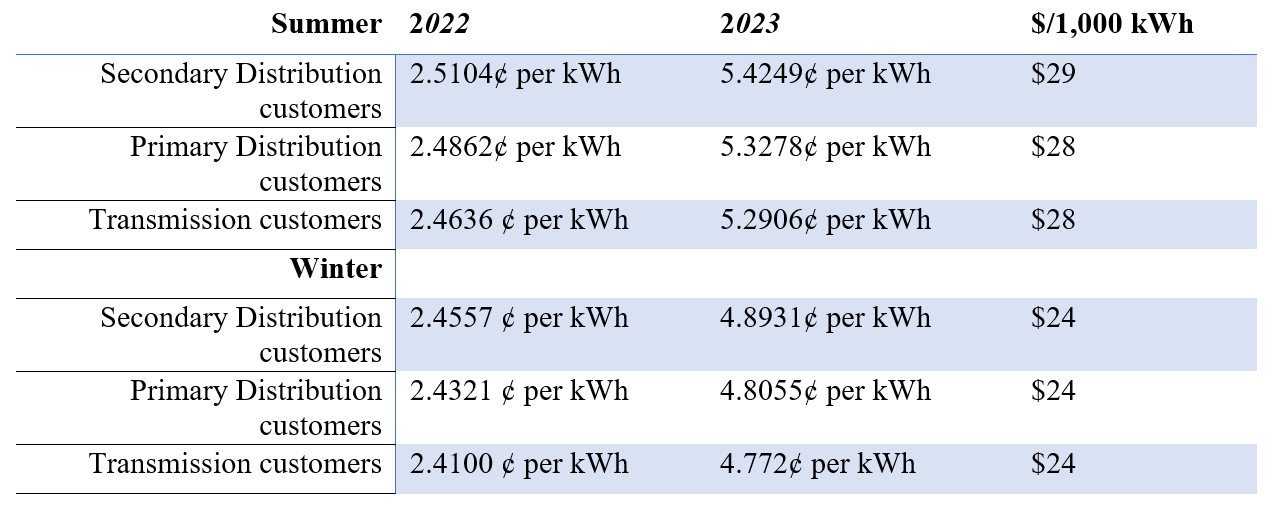IMPORTANT MONTHLY UPDATES AND ANNOUNCEMENTS
In this month’s newsletter, we take a deep dive into Georgia Power’s net metering (NEM) changes, rate increases, and future updates. We also highlight a new popular global rate available for LUMA Energy users in Puerto Rico, and we explain an increasingly common charge type that we utilize in our rates.
Georgia Power NEM Changes and Rate Updates
Georgia Power finalized its “Renewable and Nonrenewable Resources Schedule” (RNR-11) for new and preexisting solar customers. Georgia Power has two solar programs: RNR-Monthly Netting and RNR-Instantaneous Netting—the former is the original NEM pilot program capped at 5,000 customers, while the latter is for all new solar installations. Customers in the RNR-Monthly Netting program are now grandfathered until 2038, and they will continue to have their solar generation netted against their energy consumption each month. On the other hand, new solar customers receiving RNR-Instantaneous Netting will receive the following two credits for all excess energy exported back to the grid:
- Renewable Generation Credit at the Solar Avoided Energy Cost rate of 2.676 cents/kWh
- Renewable Generation Adder at a rate of four cents per kWh
The total export value of 6.68 cents per kWh can be inputted into the Export Energy Rate field within your Energy Use Profile.
The additional four-cent increase to the export rate also comes with substantial increases to Georgia Power’s retail energy rates. The commission approved the collection of $1.8 billion over the next three years, with rate increases scheduled each year. This results in an overall rate increase of 12% by 2025, with roughly 4% increases each year. Our rates team compared the 1/1/22 and 3/1/23 updates for our three most popular Georgia Power rates—PLM, R, and GS—and saw total annual increases of 2.98%, 3.14%, and 4.48%, respectively:

These rate increases also do not factor in the impending June 2023 update to the “Fuel Cost Recovery” (FCR-25) rider. We compared the current FCR rider to the one set to go into effect in June and found that customers will pay an extra $28 per 1,000 kWh in summer and $24 in winter:

Lastly, a rate increase will likely occur when nuclear reactor Unit 4 at Plant Vogle is functional in either Q4 of 2023 or Q1 of 2024. The typical Georgia Power residential customer is already paying an additional $4 per month on their bill because of Unit 3, which is scheduled for service in May or June of 2023.
Overall, Georgia Power customers can expect significant increases in their electric bills this year and the following two years. While the utility increased the solar export rate by an additional four cents, the totality of rate increases quickly outpaces the value of exported energy for Georgia Power customers.
Our rates team will continue to capture these changes in our rates as they go into effect.
LUMA Energy Rate Additions and Updates
We recently added the rate “GST” to our list of globally maintained rates for LUMA Energy (Autoridad de Energía Eléctrica de Puerto Rico). Previously, we created rate GST as a custom rate per request to accommodate each customer’s power factor and excess demand; however, we implemented a few measures to make this rate accessible to all ETB users. Our GST rate includes two types of attributes, as seen in the following screenshot:
LUMA Energy bills customers’ demand charges based on the kVa for that month, but it also uses the measured kW to calculate tier ceilings for energy consumption. In our rates, we instead use demand ratchets to adjust the kVa by the customer’s power factor to generate the demand used to create the energy tier ceilings. If preferred, our rates team can create a more precise rate explicitly tailored towards your customer when you submit your request through our Pre-Proposal Service.
When determining which global rate to use, simply check the bills for the power factor percentage, then select the rate with the power factor bracket that you fall into. The rate with the 70%-80% attribute includes a monthly demand ratchet of 75%, while the 90%-99% includes a 95% monthly ratchet:
Lastly, excess demand is not included in our global rate because it applies to all demand that exceeds the customer’s contracted demand, which is different for each customer. If excess demand is present on your bills, then the global rate can be copied and edited to include the excess demand as part of a tiered structure.
LUMA Energy updates quarterly, so we anticipate an update in April. Our rates team will be sure to update our LUMA Energy rates once the new updates are posted. And as always, feel free to contact our rates team if you need help creating a custom rate or if you’d like our team to create one for you.
Utility Rates March 2023 FAQ:
What is the units charge type?
The “Charges Vary with Units” charge type is used in many rates in ETB Developer because it is a flexible tool that allows us to accommodate several unique rate schedule structures or customer-specific bill scenarios. In the following video, we briefly explain why we use this charge type and how it works:
Did you know? – ETB Differentiates Delivery Utilities and Energy Suppliers
ETB Developer users working in states with deregulated energy markets like Texas, Illinois, or Massachusetts may encounter bills directly from a Retail Energy Supplier (RES). In such cases, it is important to know how ETB handles these companies so that you can search for the utilities and rates that you need.
ETB’s database contains over 1,800 utilities. The utilities we include are actual utility companies that own and maintain the infrastructure required to transmit energy to customers. These utilities are referred to as transmission and delivery utilities (TDU) in deregulated energy markets because they bill customers energy charges for the maintenance of the transmission infrastructure and not for the generation (or supply) of the energy—it is the RES that bills customers for the supply of energy. This split between a RES and TDU can result in either two sets of bills or, in some cases, bills directly from the RES that include the TDU charges.
RES are not considered utilities in ETB; therefore, ETB users need to determine the TDU that their customer is with. For example, searching in ETB for Constellation Energy, a common RES, yields no results:
However, searching for a TDU like Ameren – Illinois allows for the selection of a rate schedule, and the Retail Supply Details section in the Energy Use Profile allows users to customize that rate schedule to match the energy rate from the RES:
If you need assistance interpreting bills or adding a utility into ETB, reach out to our utility rates team at utilityraterequest@energytoolbase.com, and we’d be happy to help!





